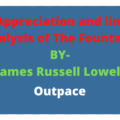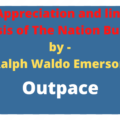About the poet:
Denis Martindale is a contemporary English poet who encourages people to reflect on the beauty of wildlife. He has written over five hundred poems on various themes.
Some of his famous works are “Portrait of a Prince”, “Out of Reach”, “Eyes of Warning”, “The Prospector’s Parable”, “The Perfect Poem!”, “Lord and Lady”, and lot more.
His poems mostly focus on wildlife because of his immense love for nature, mostly animals.
About the Poem
In the poem “Portrait of a Prince”, the poet wanted to portray the beauty of tigers. We are usually scared of wild animals, like tigers mainly due to their appearance. The poet has not only made a beautiful physical portrayal but also a deep mental connection with the tiger has also been expressed in the poem. The poet highlighted the heroic side of the tiger and not the scary side.
Structure of the Poem
Portrait of a Prince
“Behold the tiger's face up close,
With all its deep-etched lines.
Like charcoal ridges by his nose,
How clearly each defines.
Behold the tiger's ears erect,
Aware of all that breathes,
With mental filters that select
The rustling of the leaves.
Behold the tiger's eyes that stare,
As if right through your soul,
To challenge you, be wise, beware,
Take care who's in control...
Behold the tiger's nose below,
It tells him distant facts,
Though out of sight, he's in the know,
So watch out if he acts...
Behold the tiger's tight-lipped mouth,
He hides his daggers well...
His top set north, his dropped set south,
What tales those teeth could tell.
Behold the tiger's neck so still
And poised with regal grace,
Portraying here the prince's will,
Despite the human race...
Behold the tiger's sovereign style,
His sense of who he is...
His wicked ways, his covering guile,
His final parting kiss...
Behold the tiger's treachery!
Flee from his handsome grin!
For in a race, I think you'll see,
That tigers always win!”
The rhyming scheme of the poem is ababcdcdefef…
Line by Line Analysis
Stanza 1
“Behold the tiger's face up close,
With all its deep-etched lines.
Like charcoal ridges by his nose,
How clearly each defines.”
In the first stanza, the physical features of the tiger are being highlighted. The poet has not included just mere definitions of the features but also emphasized their significance beautifully. The poet has asked his readers to focus on the tiger’s face. The deeply etched lines on his face and the dark ridges near the nose are defined very well in a very clear way.
Stanza 2
“Behold the tiger's ears erect,
Aware of all that breathes,
With mental filters that select
The rustling of the leaves.”
The second stanza is also concerned mostly about the physical appearance of the tiger. The main focus is on the ears. But it is more than just the description of the ears. The poet has said that the ears are erect enough to capture all kinds of sounds around the tiger making him well aware of his surroundings. The mindset of the tiger has also been talked about where it recognises each sound made by the leaves in the forest.
Stanza 3
“Behold the tiger's eyes that stare,
As if right through your soul,
To challenge you, be wise, beware,
Take care who's in control...”
This stanza talks about the eyes and stare of the tiger. As per the poet, the stare is so sharp that it can pierce through one’s soul. The poet has also made it clear that in case of a challenge with the tiger, what needs to be very clear of the fact about who is in advantage (the tiger). According to the poet, the tiger is not just physically strong but also emotionally very strong and stable.
Stanza 4
“Behold the tiger's nose below,
It tells him distant facts,
Though out of sight, he's in the know,
So watch out if he acts...”
In the fourth stanza, the poet talks about the tiger’s amazing ability to capture smells and recognize it. This ability helps him understand things from a distance. In the last two lines of the fourth stanza, it is said that, even if the tiger is out of sight and one cannot see it, the tiger is always watching and is careful about its surroundings, so one must act accordingly because often the moves of the tiger become unpredictable and sudden.
Stanza 5
“Behold the tiger's tight-lipped mouth,
He hides his daggers well...
His top set north, his dropped set south,
What tales those teeth could tell.”
This stanza highlights the teeth. The tiger hides his teeth by his tight lips. Those teeth could tell many stories, tales of all other creatures the tiger had killed.
Stanza 6
“Behold the tiger's neck so still
And poised with regal grace,
Portraying here the prince's will,
Despite the human race...”
The tiger has amazing grace and he carries himself with that grace, even when he is preying. Here the tiger is compared to a ‘prince’. The tiger is said to be as royal and majestic as a ‘prince’ despite the presence of a human race. The human race is usually considered as the most intriguing beings. But the tiger has proved to be the more intelligent and stronger one.
Stanza 7
“Behold the tiger's sovereign style,
His sense of who he is...
His wicked ways, his covering guile,
His final parting kiss...”
This stanza depicts the royal nature of the tiger. The dignity that the tiger carries himself with is outstanding. His wicked acts and cunningness along with the final departure- all makes him supreme and majestic.
Stanza 8
“Behold the tiger's treachery!
Flee from his handsome grin!
For in a race, I think you'll see,
That tigers always win!”
The tiger’s deceitfulness should be taken into account and one should be very careful. The poet has said that if there is a race, the tiger would always win. This makes the tiger an apex predator. This stanza shows how powerful and intelligent tigers can be.
ALSO READ –
- Perform Online Pokies Regarding Real Money Lucky Cash Codes No Max Cashout No Down Payment Bonuses
- Uptown Pokies Mobile Online Casino Regarding Australian Participants
- Find Out Uptown Pokies On Line Casino And Carrier Your Self A Massive $8,888 Plus Three Hundred And Fifty Spins To Take Enjoyment In Top-tier Online Pokies Gaming!
- Discover Typically The Amazing Provides At 500 Online Casino Catch The Chance Now!
- Leading Jili Slot Machines 777online On Range Casino Within Generally The Philippines Maxabout News
Figures of Speech Used in the Poem
Hyperbole:
This is a figure of speech where overstatement is made in order to make a statement more emphatic.
“Behold the tiger’s eyes that stare
As if right through your soul.”
Onomatopoeia
in this figure of speech, certain words are used only to express some specific sounds or noises.
“The rustling of the leaves.”
Personification
Personification is a figure of speech in which animals or other inanimate objects are credited with human feelings, emotions and abilities.
“Behold the tiger’s sovereign style”
“Behold the tiger’s neck so still
And poised with regal grace”
“Flee from his handsome grin!”
Metaphor
In this figure of speech, a comparison is made without the usage of any comparing words.
“He hides his daggers well…”
The word “daggers” means teeth. To emphasise on the sharpness of the teeth, it has been compared with daggers.
Glossary
Rustling: Soft crackling sound made by leaves.
Regal: Magnificent (like a ruler).
Sovereign: Characteristic of a royal.
Guile: Artful deception.
Treachery: Deceitfulness.
Poised: Dignified.
The theme of the Poem
The poem has a theme that is mainly based on nature and wildlife. It is about tigers to be precise. The poet beautifully has portrayed the heroism and beauty of tigers. The poet had wanted the readers to fall in love with these beautiful wildlife creatures.
ALSO READ –
- Perform Online Pokies Regarding Real Money Lucky Cash Codes No Max Cashout No Down Payment Bonuses
- Uptown Pokies Mobile Online Casino Regarding Australian Participants
- Find Out Uptown Pokies On Line Casino And Carrier Your Self A Massive $8,888 Plus Three Hundred And Fifty Spins To Take Enjoyment In Top-tier Online Pokies Gaming!
- Discover Typically The Amazing Provides At 500 Online Casino Catch The Chance Now!
- Leading Jili Slot Machines 777online On Range Casino Within Generally The Philippines Maxabout News
Textbook Solutions
1.Which three senses of the tiger does the poet highlight?
Ans: The poet has highlighted the sense of hearing (in second stanza), sense of sight and smell (in the third and fourth stanza respectively) of the tiger in the poem.
2.Which line suggests that the tiger is the ‘apex predator’?
Ans: The following line suggests that the tiger is the ‘apex predator’
“For in a race, I think you’ll see,
That tigers always win!”
In the above line, the poet has said that the tiger would always win. He highlighted the heroic side of the tiger here quoting that the tiger is the best at what he does, that is preying.
3.What does the tiger have ‘control’ of?
Ans: In case there is a chase, the tigers are always in control because of their excellent senses and qualities. They are always one step ahead from their opponents. The tiger is in control of the whole race then
4.‘Though out of sight, he’s in the know.’ What does the tiger ‘know’?
Ans: The tiger knows what is happening around him and he is well aware of his surroundings, even when he is not around. That is because of his excellent sense of hearing and smell.
5.What do you think the poet means by saying, ‘despite the human race’?
Ans: Human race is usually considered to be the most significant creatures. But in the poem, tigers are depicted as the royal and majestic creatures. So, the poet wanted to say that despite the presence of the human race, the tigers can be considered as the superior creatures, because they possess both strength and intelligence at its extremity.
6.‘Behold the tiger’s treachery!
Flee from his handsome grin!
For in race, I think you’ll see,
That tigers always win!’
(i) What does the poet mention about ‘tiger’s treachery’?
(ii) Why has the poet used the word ‘handsome’ to describe the tiger’s grin?
(iii) Against whom do you think tigers always win?
Ans: (i) The poet has told that one needs to be very careful about the tiger’s treachery or deceitfulness. The ‘handsome grin’ might have something hidden beneath it. The poet has justified it saying that in case of a chase, the tiger would always win, making him an apex predator.
(ii) The poet has used the word ‘handsome’ to describe the tiger’s expressions. In the whole poem, this wild animal has been described in a royal and majestic way. Thus, he has used the word ‘handsome’ to designate the grin.
(iii) As per the poet, the tigers can win against anyone he is in a race with. With his excellent sense of smell, sight and hearing; it can leave anybody behind and lead the way.
7. Do you think the title of the poem is suitable? Why?
Ans: The title of the poem ‘Portrait of a Prince’ is very much suitable. The tiger is considered as a royal creature in the poem. His behaviour and the way he preys upon has been recognised as an act of royalty and sovereignty. In the title, ‘Prince’ is being referred to the tiger. Since the whole poem is about a tiger, the title does justice with the poem.
8.If someone asked you why we should save tigers, what will your answers be?
Ans: Tigers need to be saved for various reasons. Firstly, it is a top predator and is an important part of the ecosystem and food chain. They are majestic creatures and they are getting endangered due to their beautiful features and other reasons. Thus, they need to be conserved. Three subspecies of tigers have already been declared extinct (Bali, Caspian and Javan tigers). Basically, saving tigers is equivalent to saving the ecosystem. Every creature forms an important part of the ecosystem and needs to be saved.








Thank you for your poetry analysis. The poem is on the poemhunter website and is part of a wildlife art poetry collection of paintings by UK artist Stephen Gayford who provided the titles for the paintings and I use these titles for the poems. The 2,900+ poems can be downloaded as a free e-book PDF file on the poemhunter website yet my domain name website leads to the A to Z list of the poem titles. In October 2020, I decided to update the poem’s web page with my personal notes regarding this tiger poem which has been featured on the YouTube website. I created a picture below the poem which shows the tiger painting as well as the explanations of the verses.
http://www.poemhunter.com
http://denismartindale.co.uk
http://www.poemhunter.com/poem/portrait-of-a-prince/
IMAGE WITH PAINTING AND MY NOTES:
http://www.poemhunter.com/i/poem_image/37/59292737_poem_50.png
There are hundreds of Stephen Gayford prints being sold on eBay:
http://www.ebay.co.uk
http://www.ebay.ie
Regards, Denis Martindale.
DENIS MARTINDALE. OCTOBER 2020.